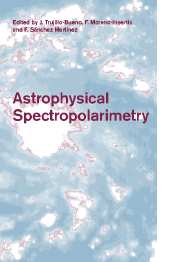Book contents
- Frontmatter
- Contents
- Participants
- Group Photograph
- Preface
- Foreword
- Acknowledgements
- The Physics of Polarization
- Polarized Radiation Diagnostics of Solar Magnetic Fields
- Polarized Radiation Diagnostics of Stellar Magnetic Fields
- Polarization Insights for Active Galactic Nuclei
- Compact Objects and Accretion Disks
- Astronomical Masers and their Polarization
- Interstellar magnetic fields and infrared-submillimeter spectropolarimetry
- Instrumentation for Astrophysical Spectropolarimetry
Instrumentation for Astrophysical Spectropolarimetry
Published online by Cambridge University Press: 21 May 2010
- Frontmatter
- Contents
- Participants
- Group Photograph
- Preface
- Foreword
- Acknowledgements
- The Physics of Polarization
- Polarized Radiation Diagnostics of Solar Magnetic Fields
- Polarized Radiation Diagnostics of Stellar Magnetic Fields
- Polarization Insights for Active Galactic Nuclei
- Compact Objects and Accretion Disks
- Astronomical Masers and their Polarization
- Interstellar magnetic fields and infrared-submillimeter spectropolarimetry
- Instrumentation for Astrophysical Spectropolarimetry
Summary
Astronomical spectropolarimetry is performed from the X-ray to the radio regimes of the electromagnetic spectrum. The following chapter deals with instruments and their components that are used in the wavelength range from 300 nm to 20 µm. After introducing the terminology and formalisms that are used in the context of astronomical spectropolarimeters, I discuss the most widely used optical components. These include crystal and sheet polarizers, fixed monochromatic and achromatic retarders, and variable retarders such as liquid crystals and photoelastic modulators. Since polarimetric measurements are often limited by systematic errors rather than statistical errors due to photon noise, I deal with these instrumentally induced errors in detail. Among these errors, I discuss instrumental polarization of various kinds and chromatic and angle of incidence errors of optical components. I close with a few examples of successful, modern night-time and solar spectropolarimeters.
Introduction
Scope of chapter
Astronomical polarimetry is performed over a large fraction of the electromagnetic spectrum, from X-rays to radio waves. The following chapter is restricted to the optical range that can be observed from the ground, i.e. 300 nm to 20 µm. Far-infrared polarimetry is described by Hildebrand in this volume. Information on polarimetry in the X-ray and radio regimes can be found in Tinbergen (1996).
Furthermore, the following text focuses on instruments for spectropolarimetry, i.e. the instrumental aspects of polarimetry with a spectral resolution that resolves spectral lines, either with a spectrograph or a filter, i.e. a spectral resolution of λ/δλ = R > 10,000.
- Type
- Chapter
- Information
- Astrophysical Spectropolarimetry , pp. 303 - 354Publisher: Cambridge University PressPrint publication year: 2001
- 16
- Cited by



